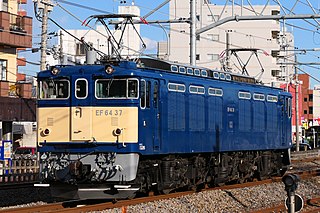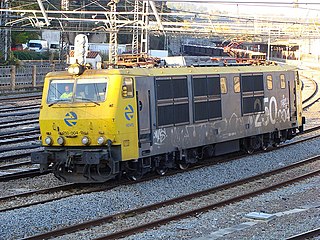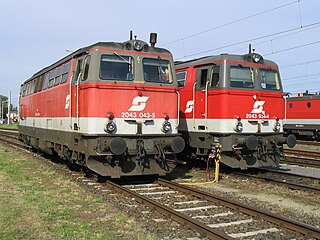
Japan Freight Railway Company, or JR Freight, is one of the seven constituent companies of Japan Railways Group. It provides transportation of cargo nationwide throughout Japan. Its headquarters are in Shibuya, Tokyo near Shinjuku Station.

The Railway Museum is a railway museum in Saitama, Saitama, Japan, which opened on 14 October 2007. It was built and is operated by the East Japan Railway Culture Foundation, a non-profit affiliate of the East Japan Railway Company. It consists of a 19,800 m² building on a site covering 42,500 m², with a display area 9,500 m² in size.

The Cassiopeia is a luxury charter train service in Japan, operated by East Japan Railway Company. It used to operate as a Limited express from July 1999 until March 2016. It ran between Ueno Station in Tokyo and the city of Sapporo in the northern island of Hokkaido. The one-way journey took approximately 16½ hours.

The Class EF60 (EF60形) was the first Japanese second-generation DC electric locomotive type with six driven axles, and the first versions used the same MT49 390 kW traction motors as the ED60 and ED61 designs. A total of 143 locomotives were built between 1960 and 1964 by Kawasaki, Tōshiba, Tōyō & Kisha Seizō, and Mitsubishi. The class was split between 129 freight locomotives designed to supersede the mammoth EH10s on Tōkaidō and Sanyō Main Line freight, and 14 passenger locomotives (EF60-500) to replace EF58s on sleeping car trains on the Tōkaidō and Sanyō Mainlines.

The Class EF62 (EF62形) is a Co′Co′ wheel arrangement DC electric locomotive type built between 1962 and 1969 for use hauling passenger and freight on the Shinetsu Main Line and particularly over the extreme 66.7‰, (6.67%), gradient of the Usui Pass between Yokokawa and Karuizawa. The prototype, EF62 1, was built by Kawasaki Sharyō in 1962, with the full-production locomotives built by Kawasaki, Tōshiba, and Tōyō & Kisha delivered from 1963 onward.

The Class EF1 was a class of electrically powered locomotives built by the North Eastern Railway from 1914. They were built to haul coal trains from the mines at Shildon to the docks at Middlesbrough. In common with other LNER electric locomotives, no classification was given to these locomotives until 4 October 1945, when nos. 3-12 were all classified EB1 although only no. 11 was actually modified for banking. It was expected that all the locomotives would be similarly modified, but this did not happen, and the remaining locos were classified as EF1.

The Class EF64 (EF64形) is a 6-axle DC electric locomotive type operated on passenger and freight services in Japan since 1964.

The Akebono (あけぼの) was a seasonal limited express sleeper train service operated by East Japan Railway Company, which ran from Ueno Station in Tokyo to Aomori, via the Joetsu Line, Uetsu Main Line and Ou Main Line. The journey took approximately 12 hours.

The Class EF66 (EF66形) is a six-axle, three-bogied (Bo′Bo′Bo′) DC electric locomotive designed for fast freight used by Japanese National Railways (JNR) and later operated by its descendants JR West and JR Freight. As of 1 April 2016, 39 locomotives remained in service, all operated by JR Freight.

The Class EF65 (EF65形) is a 6-axle DC electric locomotive type operated on passenger and freight services in Japan since 1965. A total of 308 locomotives were built between 1965 and 1979, with 52 still in service as of 1 April 2016.

The Class EF200 (EF200形) was a Bo-Bo-Bo wheel arrangement DC electric locomotive operated by JR Freight on freight services in Japan from 1992 until its retirement on 28 March 2019.

The Class EF81 is a six-axle Bo-Bo-Bo wheel arrangement multi-voltage AC/DC electric locomotive type operated on passenger and freight services in Japan since 1968. As of 1 April 2016, 44 locomotives remained in service, operated by JR Freight, JR East, and JR West.

The Renfe Class 252 are a series of Bo'Bo' electric locomotives, built by CAF, Meinfesa, Siemens and Krauss-Maffei for RENFE. 15 units were built for the AVE Madrid–Seville high speed line in, and 60 units constructed for general use to Iberian gauge (1668mm).

The Class EF70 (EF70形) is a Bo-Bo-Bo wheel arrangement AC electric locomotive type operated by Japanese National Railways (JNR) in Japan from 1961 until the 1980s. 81 locomotives were built by Hitachi and Mitsubishi between 1961 and 1965.
The Class ED74 (ED74形) was a Bo-Bo wheel arrangement AC electric locomotive type operated by Japanese National Railways (JNR) in Japan between 1962 and the 1980s.

The Renfe Class 269 is a class of electric locomotives operated by Renfe in Spain. They were built by CAF and Macosa under license from Mitsubishi.

The Renfe Class 250 is a class of electric locomotives operated by Renfe in Spain, built by Krauss Maffei and CAF.

The ÖBB Class 2143 is a class of diesel-hydraulic locomotives operated by Austrian Federal Railways (ÖBB) in Austria.

The ÖBB Class 2043 is a class of diesel-hydraulic locomotives operated by Austrian Federal Railways (ÖBB) in Austria.

The Renfe Class 321 is a class of diesel-electric locomotives operated by Renfe in Spain, designed by Alco and built by them and by Euskalduna under licence.




















